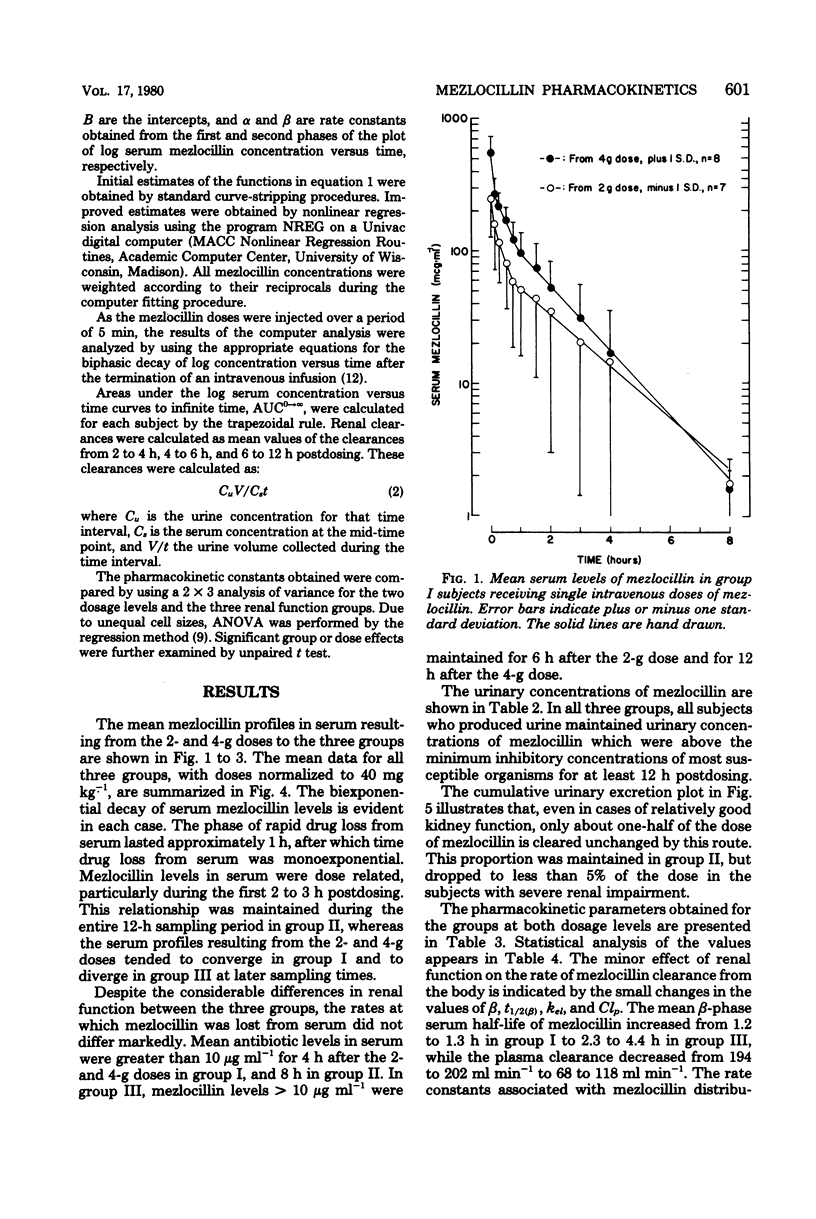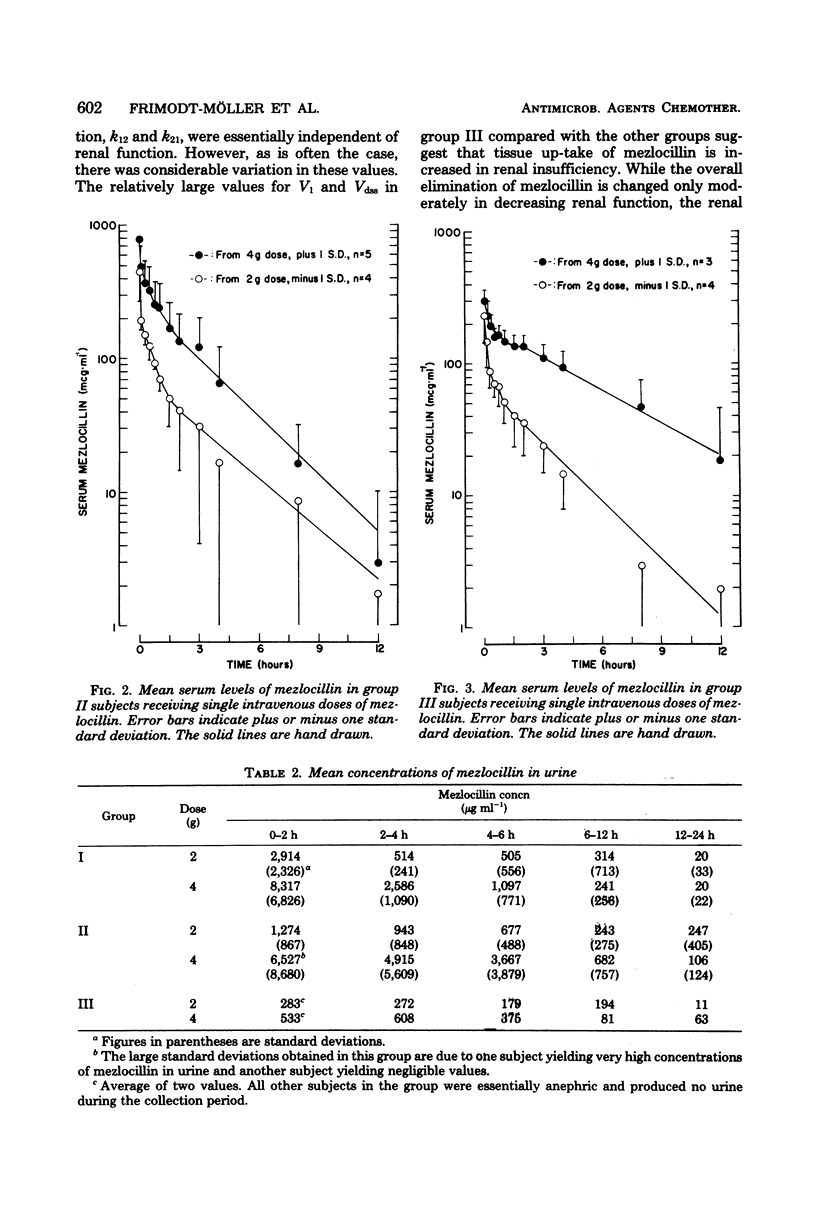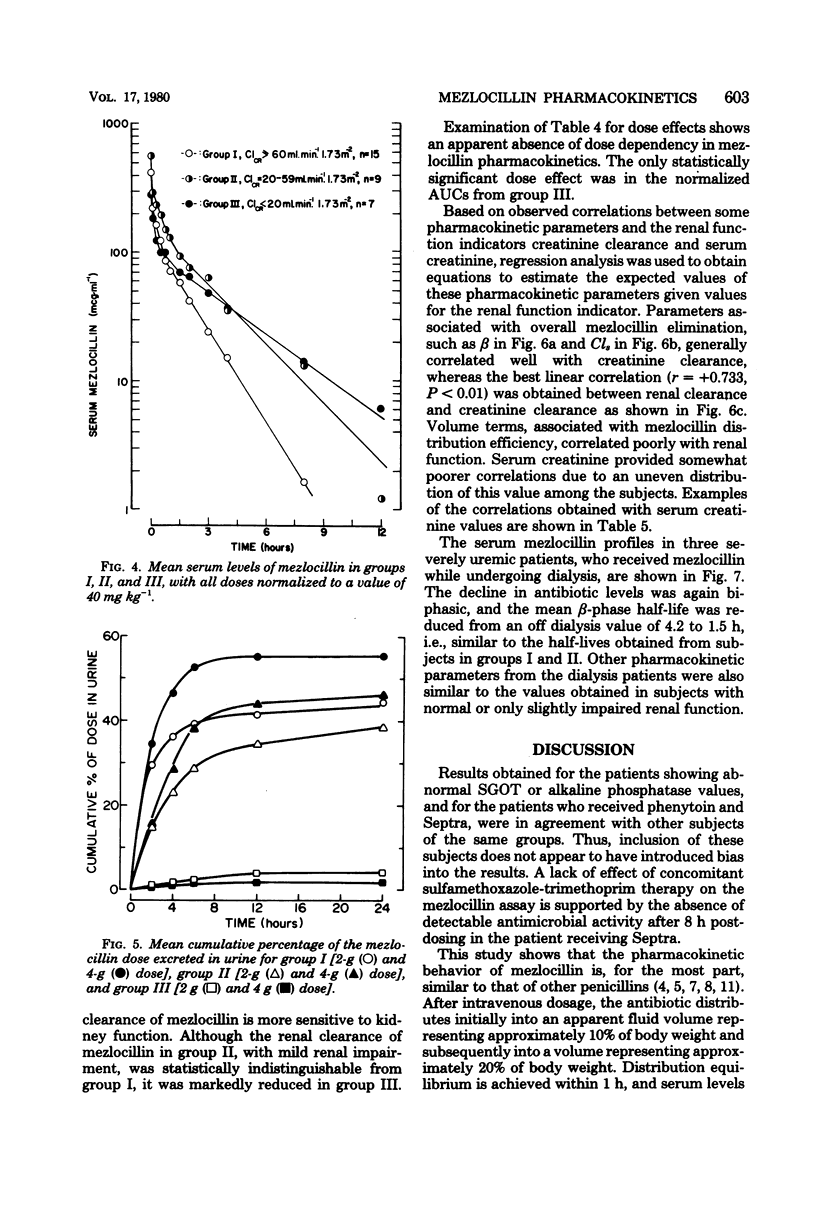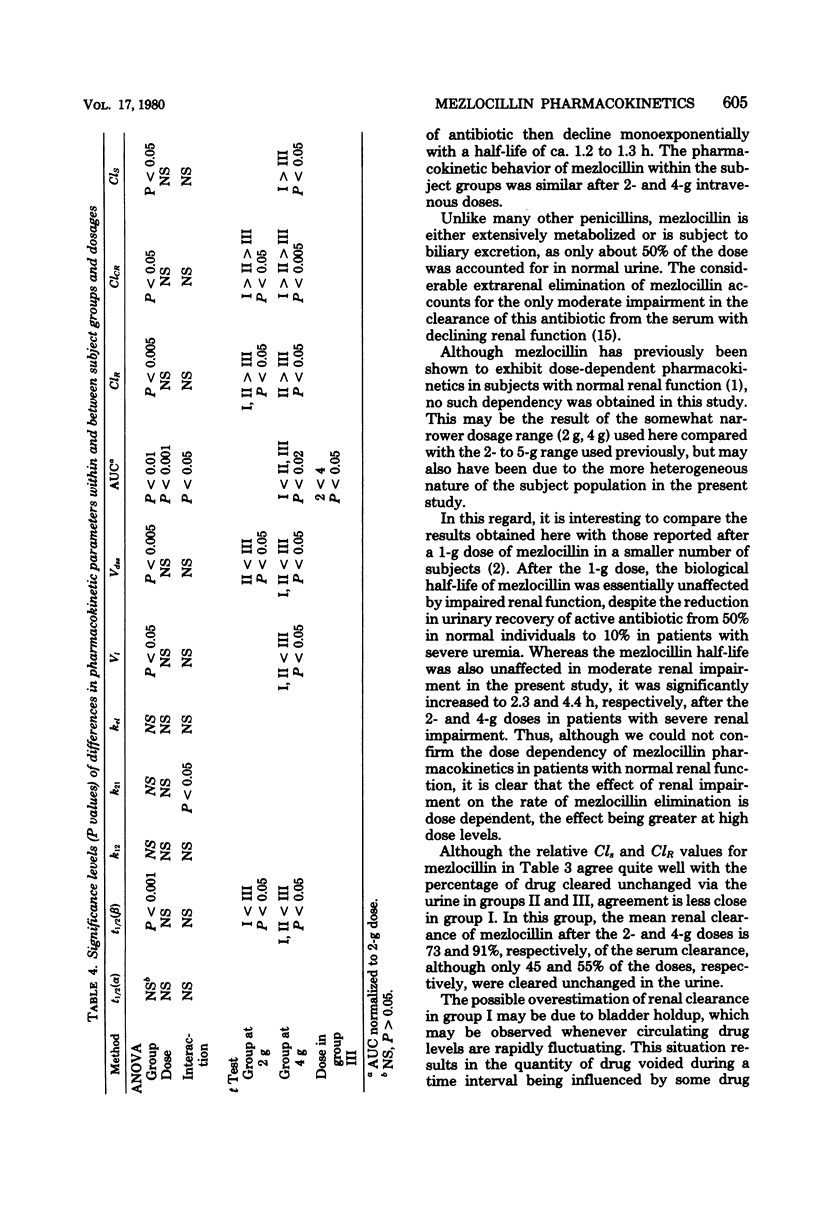Abstract
The pharmacokinetics of mezlocillin were examined after single 2- and 4-g intravenous injections to three groups of male patients with creatinine clearances of I ≥ 60, II = 21 to 59, and III ≤ 20 ml min−1 1.73 m−2. The decline in serum antibiotic levels was biphasic in all groups, and serum data were interpreted in terms of the pharmacokinetic two-compartment model. The mean elimination half-life of mezlocillin after the 2-g dose was 1.3, 1.5, and 2.3 h in groups I, II, and III, respectively. Equivalent values after the 4-g dose were 1.2, 1.6, and 4.4 h. In three functionally anephric patients the mean serum half-life of mezlocillin was 1.5 h during hemodialysis. Mean antibiotic levels in serum were greater than 10 μg ml−1 for 4 h after the 2- and 4-g doses in group I and 8 h in group II. In group III, levels greater than 10 μg ml−1 were maintained for 6 h after the 2-g dose and over 12 h after the 4-g dose. Mezlocillin distribution characteristics were largely independent of renal function and dose size. The only observable change occurred in the value of Vdss, which was significantly increased to 0.32 with 0.38 liter kg−1 in severe renal impairment, compared to ca. 0.2 liter kg−1 in subjects with normal or slightly impaired renal function. Cumulative 24-h urinary excretion accounted for 50, 40, and 3.2% of the dose in groups I, II, and III, respectively. Urine levels of mezlocillin were uniformly greater than the minimum inhibitory concentration for susceptible organisms for 12 h after dosing in all patients who produced urine. Because of the relatively small increase in the mezlocillin elimination half-life with declining renal function, dose reduction is necessary only in cases of severe renal impairment.
Full text
PDF








Selected References
These references are in PubMed. This may not be the complete list of references from this article.
- Bergan T., Brodwall E. K., Wiik-Larsen E. Mezlocillin pharmacokinetics in patients with normal and impaired renal functions. Antimicrob Agents Chemother. 1979 Nov;16(5):651–654. doi: 10.1128/aac.16.5.651. [DOI] [PMC free article] [PubMed] [Google Scholar]
- Bergan T. Pharmacokinetics of mezlocillin in healthy volunteers. Antimicrob Agents Chemother. 1978 Dec;14(6):801–806. doi: 10.1128/aac.14.6.801. [DOI] [PMC free article] [PubMed] [Google Scholar]
- Bodey G. P., Pan T. Mezlocillin: in vitro studies of a new broad-spectrum penicillin. Antimicrob Agents Chemother. 1977 Jan;11(1):74–79. doi: 10.1128/aac.11.1.74. [DOI] [PMC free article] [PubMed] [Google Scholar]
- Bodey G. P., Vallejos C., Stewart D. Flucloxacillin: a new semisynthetic isoxazolyl penicillin. Clin Pharmacol Ther. 1972 Jul-Aug;13(4):512–515. doi: 10.1002/cpt1972134512. [DOI] [PubMed] [Google Scholar]
- Cole M., Kenig M. D., Hewitt V. A. Metabolism of penicillins to penicilloic acids and 6-aminopenicillanic acid in man and its significance in assessing penicillin absorption. Antimicrob Agents Chemother. 1973 Apr;3(4):463–468. doi: 10.1128/aac.3.4.463. [DOI] [PMC free article] [PubMed] [Google Scholar]
- Craig W. A., Welling P. G. Protein binding of antimicrobials: clinical pharmacokinetic and therapeutic implications. Clin Pharmacokinet. 1977 Jul-Aug;2(4):252–268. doi: 10.2165/00003088-197702040-00002. [DOI] [PubMed] [Google Scholar]
- Jusko W. J., Lewis G. P. Comparison of ampicillin and hetacillin pharmacokinetics in man. J Pharm Sci. 1973 Jan;62(1):69–76. doi: 10.1002/jps.2600620112. [DOI] [PubMed] [Google Scholar]
- Kampmann J., Hansen J. M., Siersboek-Nielsen K., Laursen H. Effect of some drugs on penicillin half-life in blood. Clin Pharmacol Ther. 1972 Jul-Aug;13(4):516–519. doi: 10.1002/cpt1972134516. [DOI] [PubMed] [Google Scholar]
- Pancoast S. J., Neu H. C. Kinetics of mezlocillin and carbenicillin. Clin Pharmacol Ther. 1978 Jul;24(1):108–116. doi: 10.1002/cpt1978241108. [DOI] [PubMed] [Google Scholar]
- Rolinson G. N. Laboratory evaluation of amoxycillin. Chemotherapy. 1973;18(Suppl):1–10. doi: 10.1159/000221287. [DOI] [PubMed] [Google Scholar]
- Wagner H. Der alloplastische Gelenkflächenersatz am Hüftgelenk. Arch Orthop Unfallchir. 1975;82(2):101–106. [PubMed] [Google Scholar]
- Welling P. G., Craig W. A., Gordon A. L., Kunin C. M. Pharmacokinetics of cefazolin in normal and uremic subjects. Clin Pharmacol Ther. 1974 Apr;15(4):344–353. doi: 10.1002/cpt1974154344. [DOI] [PubMed] [Google Scholar]
- Welling P. G., Craig W. A., Kunin C. M. Prediction of drug dosage in patients with renal failure using data derived from normal subjects. Clin Pharmacol Ther. 1975 Jul;18(1):45–52. doi: 10.1002/cpt197518145. [DOI] [PubMed] [Google Scholar]
- White G. W., Malow J. B., Zimelis V. M., Pahlavanzadeh H., Panwalker A. P., Jackson G. G. Comparative in vitro activity of azlocillin, ampicillin, mezlocillin, piperacillin, and ticarcillin, alone and in combination with an aminoglycoside. Antimicrob Agents Chemother. 1979 Apr;15(4):540–543. doi: 10.1128/aac.15.4.540. [DOI] [PMC free article] [PubMed] [Google Scholar]
- Wise R., Gillett A. P., Andrews J. M., Bedford K. A. Activity of azlocillin and mezlocillin against gram-negative organisms: comparison with other penicillins. Antimicrob Agents Chemother. 1978 Apr;13(4):559–565. doi: 10.1128/aac.13.4.559. [DOI] [PMC free article] [PubMed] [Google Scholar]


